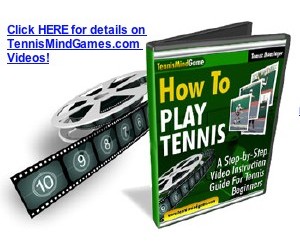January 1997 Article Turbo Tennis Archives:
Tennis Server
|

 |
When I first started playing the game of tennis some seven years ago, a friend of mine related a saying that he attributed to the famous Rod Laver. It went something like this:
"In the final analysis it all boils down to grip." Well, whether or not Mr. Laver really did make this statement, I firmly believe that the implications of this quote are quite valid. So many of you have written to me with questions regarding grip, that I decided to address this facet of the game, post haste! Before any point can begin, you have to grip the racquet. How you grip the racquet has profound impact upon how you should stand, at what moment you must hit the ball and the kind of spin that you can impart. Let's briefly review what types of grip exist (obviously, I am referring to the dominant hand's grip):
NOTE: So far, each grip change is a quarter turn different from the grip that precedes and follows it.
To help you understand the strengths and weaknesses associated with the above grips, I offer the following:
Semi-Western grips suffer some of the same pitfalls as the Western, but are a bit more flexible. They are, in my opinion, the most useful forehand grip in today's game on today's surfaces (hard courts and clay courts). They to require that the player hit the ball in front of the body...but not as far in front as is required by the Western. Low balls can present a problem unless the player learns to "lift and roll" the ball. If she/he can do this, the low ball can come back at you as a winner! The Eastern Forehand is the preferred forehand grip from the older era of tennis (when grass courts weren't so rare). It is a great grip when you want to drive the ball "flatly," but it can be used to impart either topspin or slice. Low balls are usually not a problem for a player using this grip, but high balls can result in replies that bounce out. Don't rule this grip out as your first choice! It's strength is its flexibility. An important point to realize about this grip is that you do not hit the ball in front of the body when using this grip. Rather you hit the ball parallel to the side of the body. Hitting in front will make for errant shots and probably result in a bit of arm/elbow pain. The Continental grip should be used for backhand slice, serving, overheads, and volleys (in a future article, I'll discuss why I think the Continental grip may no longer be the preferred grip for volleying). However, the "Connie" forehand is a clear liability for the modern player. Any high bouncing ball will frustrate the player who uses the Continental grip as a forehand grip. High balls are not comfortable on the backhand side, but the player can use the Continental grip and slice the high ball back with effectiveness. Only the volley should be hit in front of the body using the Continental grip. Groundstrokes (either forehand or backhand) should be hit with the ball to the side and a bit behind the body. The Eastern Backhand grip is a mainstay grip for the one-hander. You can hit low or high balls well with this grip, and you can hit topspin, flat or slice balls effectively. It is the utility grip for the one-hander. Like its forehand counterpart, this grip requires that you strike the ball parallel to the side of your body... again, not in front. The Severe Eastern Backhand grip is the topspinner's choice. It is like a Western Forehand in terms of strengths and weaknesses. The low ball presents a problem (especially with slice) and the grip really only allows for topspin (even flat shots can be difficult). If you are a clay courter, you'll want to add this grip to your arsenal. Two-handed grips are so varied that it is difficult to make generalizations. Usually, two-handers return serve well...even when served wide. The serve that comes straight at her/him is more of a problem. Two-handers usually hit flat or more likely with topspin (Connors is one of the few two- handers who can hit the slice well). Two-handers are very common today in part because this approach makes for strong grip support. However, two-handers usually don't volley well and often times have trouble with low and/or slow paced shots (in a future article, I'll address how I believe the two-hander can become an effective volleyer). I would advise two-handers to work on developing a one-hand slice that uses a Continental grip (look at what this shot adds to Mats Wilander's game!). I know that consciously thinking about grip will almost always result in a bit of paralysis by analysis. But really, there is no other way to figure out what works and what doesn't. Be prepared to be a bit frustrated as you venture down this experimentation path. In time, you'll know what grips work and when. Make written notes of your discovery process. Once you have arrived at your array of grips, solidify them through practice. Be consistent in using them!!! Perform lots of repetitive drills to firmly establish these grips in your muscle memory. Again, wall work or ball machines can greatly accelerate this process. If and when you become frustrated with a new grip (or its impact upon old grips), comfort yourself with the fact that in time it will become second nature and in time it will allow you to become a more complete player. It is my belief that many of our errors in tennis can be directly or indirectly traced to grip. Even small changes in grip can have a profound effect upon the ball's path. I think this may explain why on one day we can't seem to get a ball in, and on another day, we are "zoning" every shot. We probably think we are using the same grips on each of these days, but in reality, we have likely altered our standard grips ever so slightly. Sometimes when I am not playing well, I review my grip "cues." Frequently, I discover that I am not gripping the racquet as I should on a given shot. Once I realize the problem and make the correction, I deliberately take my mind off the grip and back onto the ball. What I don't want to do is to dwell on the grip while competing...maybe when practicing, but never when competing! Finally, pay attention to your opponent's grips. They will give you valuable insights on how to attack! Remember, no one hits every type of ball well. Once you discover what your opponent doesn't like, give her/him lots of these shots. Her/his grips are often times the cues that help you discover the weaknesses! Pay attention to your grips and to your opponent's and soon you'll become a tennis overdog! For more information on tennis grips along with extensive grip photography, be sure to read Ron's sequel to this article: The Grip: Picture Perfect.
1996 - 2002 | 2003 - Present
This column
is copyrighted by Ron Waite, all rights reserved. Questions and comments
about these columns can be directed to Ron by using this form.
Ron Waite is a certified USPTR tennis instructor who took up the game
of tennis at the age of 39. Frustrated with conventional tennis methods
of instruction and the confusing data available on how to learn the
game, Ron has sought to sift fact from fiction. In his seven years of
tennis, Ron has received USTA sectional ranking four years, has successfully
coached several NCAA Division III men's and women's tennis teams to
post season competition, and has competed in USTA National singles tournaments.
Ron has trained at a number of tennis academies and with many of the
game's leading instructors.
In addition to his full-time work as a professor at Albertus Magnus
College, Ron photographs ATP tour events for a variety of organizations
and publications. The name of his column, TurboTennis, stems from his
methods to decrease the amount of time it takes to learn and master
the game of tennis.
|



October 2022 Tennis Anyone: Patterns in Doubles by John Mills. September 2022 Tennis Anyone: Short Court by John Mills. |
 You will join 13,000 other subscribers in receiving news of updates to the Tennis Server along with monthly tennis tips from tennis pro Tom Veneziano.
You will join 13,000 other subscribers in receiving news of updates to the Tennis Server along with monthly tennis tips from tennis pro Tom Veneziano. 

